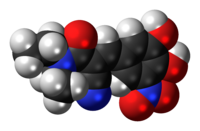Entacapone
 | |
 | |
| Clinical data | |
|---|---|
| Pronunciation | /ˌɛntəkəˈpoʊn/ or /ɛnˈtækəpoʊn/ |
| Trade names | Comtan (single ingredient), Stalevo (multi-ingredient) |
| AHFS/Drugs.com | Monograph |
| MedlinePlus | a601236 |
| License data |
|
| Pregnancy category |
|
| Routes of administration | By mouth |
| ATC code | |
| Legal status | |
| Legal status | |
| Pharmacokinetic data | |
| Bioavailability | 35% |
| Protein binding | 98% (binds to serum albumin) |
| Metabolism | Hepatic |
| Elimination half-life | 0.4–0.7 hours |
| Excretion | Feces (90%), urine (10%) |
| Identifiers | |
| |
JSmol) | |
| |
| |
| (verify) | |
Entacapone, sold under the brand name Comtan among others, is a medication commonly used in combination with other medications for the treatment of
Entacapone is a selective and
Medical uses
Entacapone is used
Entacapone is an orally active drug that can be taken with or without food.[4][6]
Pregnancy and breastfeeding
Pregnancy category C: risk is not ruled out.[2]
Although there have been animal studies that showed that entacapone was
Children
Entacapone safety and efficacy have not been assessed in infants or children.[2]
Liver problems
Biliary excretion is the major route of excretion for entacapone. People with liver dysfunction may require additional caution and more frequent liver function monitoring while taking entacapone.[2]
Kidney problems
There are no significant considerations for people with poor kidney function taking entacapone.[2]
Contraindications
There is a high risk for allergic reactions for people who are hypersensitive to entacapone.[2]
Potential limiting conditions to consider before starting entacapone include:[6]
- History of allergic reactionto entacapone
- History of liver dysfunction, or alcoholism
- Current or planned pregnancy
- Current or planned surgeries
Side effects
The following
- Abdominal pain
- Nausea
- Vomiting
- Fatigue
- Dry mouth
- Back ache
Movement problems
The most common side effect of entacapone is movement problems, which occur in 25% of people taking entacapone.[2] This drug may cause or worsen dyskinesia for people with Parkinson's disease treated together with levodopa and carbidopa.[2] In particular, "peak-dose dyskinesias" may occur when levodopa levels are at its peak concentration in the serum plasma.[7][8]
Diarrhea
10% of patients taking entacapone have been shown to experience diarrhea.[2] Diarrhea may occur within 4–12 weeks of initial entacapone use but resolves after discontinuation of the drug. Use of entacapone in the presence of diarrhea can also be associated with weight loss, low potassium levels, and dehydration.[2] In clinical studies, severe diarrhea was the most common reason for discontinuation of entacapone.[9]
Urine color
10% of people taking entacapone experience a change in urine color to orange, red, brown, or black. This side effect is due to entacapone metabolism and excretion in the urine and shown to not be harmful.[9]
Sudden sleep onset
People have reported sudden sleep onset while engaging in daily activities without prior warning of drowsiness. In controlled studies, patients on entacapone had a 2% increased risk of somnolence compared to placebo.[2]
Low blood pressure
Episodes of orthostatic hypotension have been shown to be more common at the start of entacapone use due to increased levels of levodopa.[2]
Behavior problems
People taking entacapone may experience increased urges to participate in gambling, sexual activities, money spending, and other stimulating reward behaviors.[2]
Interactions
In studies, entacapone has shown a low potential for interaction with other drugs. In theory, it could interact with
Pharmacology
Mechanism of action
Entacapone is a selective and reversible
For the treatment of Parkinson's disease, entacapone is given as an adjunct to levodopa and an aromatic amino acid decarboxylase inhibitor, carbidopa. Entacapone inhibits COMT in the periphery (but not, or at most marginally, in the brain[11]) and the metabolism of levodopa, thus increasing plasma levels of levodopa and causing more constant dopaminergic stimulation in order to reduce the signs and symptoms presented in the disease.[2]
Pharmacokinetics
Absorption
The time to highest blood plasma concentrations is approximately one hour. The substance undergoes extensive
Distribution
The
Metabolism and elimination
Entacapone is primarily metabolized to its
References
- ^ Anvisa (31 March 2023). "RDC Nº 784 - Listas de Substâncias Entorpecentes, Psicotrópicas, Precursoras e Outras sob Controle Especial" [Collegiate Board Resolution No. 784 - Lists of Narcotic, Psychotropic, Precursor, and Other Substances under Special Control] (in Brazilian Portuguese). Diário Oficial da União (published 4 April 2023). Archived from the original on 3 August 2023. Retrieved 16 August 2023.
- ^ a b c d e f g h i j k l m n o p q r s t u v w x y "Comtan Full Prescribing Information-Novartis" (PDF). Pharma.us.novartis.com. July 2014. Archived from the original (PDF) on 15 March 2016. Retrieved 4 November 2015.
- ^ "Stalevo- carbidopa, levodopa, and entacapone tablet, film coated". DailyMed. 7 January 2020. Retrieved 14 March 2020.
- ^ a b "PubMedHealth". PubMedHealth. 1 October 2015. Retrieved 4 November 2015.
- ^ S2CID 71616140.
- ^ a b c "Entacapone". Medlineplus - NIH. American Society of Health-System Pharmacist. September 2010. Retrieved 4 November 2015.
- ^ "Late (complicated) Parkinson's Disease". National Guideline Clearing House. November 2006. Archived from the original on 24 October 2015. Retrieved 3 November 2015.
- PMID 23948989.
- ^ ISBN 978-1609137137.
- ^ a b c d "Comtan: EPAR – Product Information" (PDF). European Medicines Agency. 10 March 2015. Archived from the original (PDF) on 16 March 2018. Retrieved 17 April 2017.
- ISBN 978-3-7741-9846-3.
